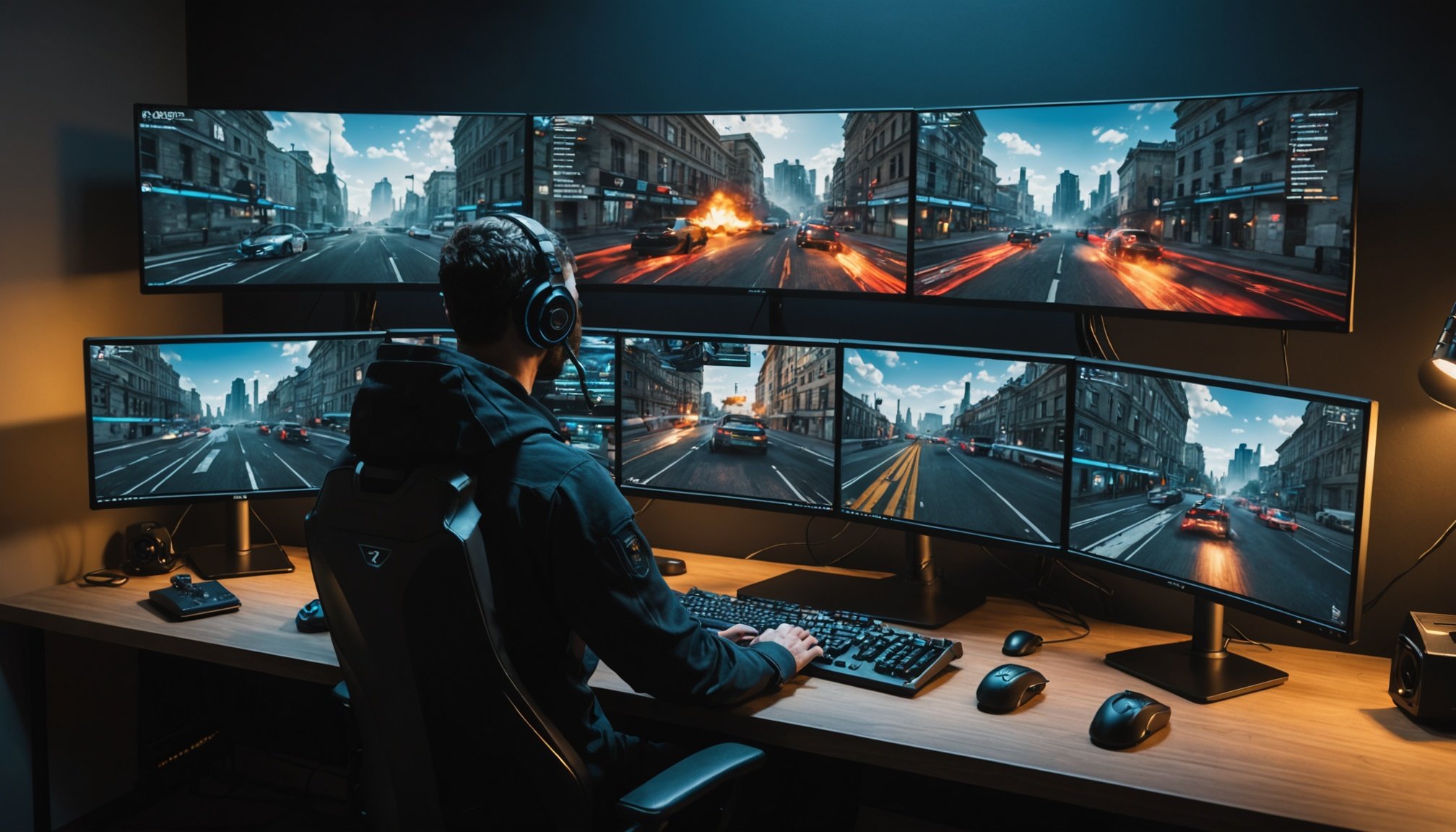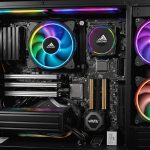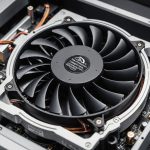Mastering Multi-Monitor Setup for an Unmatched Gaming Experience
Why Go for a Multi-Monitor Setup?
In the world of gaming, the pursuit of an immersive and efficient experience is relentless. One of the most effective ways to enhance your gaming setup is by incorporating multiple monitors. A multi-monitor setup can significantly boost your productivity, management, and overall gaming experience. Here’s a comprehensive guide to help you master the art of setting up multiple monitors for an unparalleled gaming experience.
Choosing the Right Monitors
When it comes to selecting monitors for your gaming setup, several factors need to be considered to ensure you get the best performance.
In the same genre : Exploring the contrasts: rgb vs. non-rgb components in pc builds
Optimal Display Quality
For a seamless gaming experience, you need monitors that excel in display quality. Look for monitors known for their precise color reproduction and wide color gamut. Professional-grade monitors, such as those from BenQ, offer excellent color accuracy, ensuring your visuals are displayed with accuracy and detail[3].
Seamless Viewing Experience
Positioning your monitors side by side with minimal bezel gap is crucial for a seamless viewing experience. Monitors with thin bezels maximize screen real estate and minimize distractions, allowing you to work or game seamlessly across both screens[3].
Also to read : Maximize Your Gaming with Our Comprehensive Guide to Enhancing the Alienware Aurora R11 GPU!
Ergonomic Design
Ergonomic comfort is essential for long gaming sessions. Choose monitors that offer adjustable stands or compatible mounting options. Customizing the height, tilt, and swivel of your monitors can significantly reduce strain and enhance your overall comfort[3].
Connectivity Options
Ensure your monitors provide a range of connectivity options such as HDMI, DisplayPort, or USB-C/Thunderbolt 3. This versatility ensures compatibility with various devices and facilitates an easy and convenient setup process[3].
Setting Up Your Monitors
Setting up multiple monitors involves more than just connecting them to your PC. Here’s a step-by-step guide to help you get started.
Hardware Requirements
Before you begin, make sure your PC has the necessary hardware to handle multiple monitors. A mid-range to high-end discrete graphics card is essential. Modern graphics cards like the AMD 5700XT and NVIDIA RTX 2070 have multiple DisplayPort connectors and at least one HDMI port, which is more than enough for a dual or triple screen setup[1].
Video Connections
Digital connections are key to a multi-monitor setup. Use HDMI and DisplayPort for the best results. DisplayPort, especially since version 1.2, allows for daisy chaining, where you can connect multiple monitors using a single DisplayPort cable from your PC to the master monitor, and then from the master monitor to additional screens[1].
| Connection Type | Description |
|---|---|
| HDMI | Commonly used, supports up to 4K resolution |
| DisplayPort | Ideal for multiple monitors, supports daisy chaining |
| DVI | Older technology, still supported but less common |
| USB-C | Emerging as a graphics connection, but not yet fully established |
| VGA | Legacy technology, not recommended for multi-monitor setups |
Power and Cabling
Each monitor requires a power connection, so ensure you are comfortable with the added cabling and slightly higher electric bills. Avoid using splitters as they can introduce compatibility and bandwidth issues, affecting image performance[1].
Configuring Your Display Settings
Once your monitors are connected, you need to configure the display settings in your operating system.
Windows Settings
In Windows 10 or 11, right-click on the desktop and go to Display settings. Here, you’ll see a schematic representing your monitors. Use the Identify button to list all connected monitors and rearrange them as needed. You can choose to extend the display, duplicate the desktop, or set up a specific arrangement that suits your gaming needs[1][2].
Graphics Card Settings
For more advanced settings, use the AMD Catalyst Control Center or NVIDIA Control Panel. These tools allow you to configure your monitors in detail, including setting up Eyefinity for AMD cards or GeForce Surround for NVIDIA cards[1].
Enhancing Your Gaming Experience
A multi-monitor setup can significantly enhance your gaming experience in several ways.
Immersive Gaming
With multiple monitors, you can create an immersive gaming environment. For example, you can run your game on one monitor, display mission-critical information on another, and use the third to adjust your live streaming settings if you are a streamer[2].
Boosting Productivity
Beyond gaming, a multi-monitor setup can also boost your productivity. You can use one monitor for your game, another for chat or social media, and a third for resource-intensive applications like video editing or data analysis[2].
Ergonomics and Desk Setup
A well-organized desk is crucial for a comfortable and efficient multi-monitor setup.
Desk Selection
Choose a desk that can accommodate all your monitors and peripherals. An L-shaped desk can be particularly useful if you have limited space, as it utilizes the corners of your room effectively[2].
Monitor Mounts
Use adjustable monitor stands or mounts to position your monitors at comfortable heights and viewing angles. This not only enhances ergonomics but also keeps your desk clutter-free[2].
Advanced Considerations for Serious Gamers
For those who are serious about their gaming setup, here are some advanced considerations.
Dual Graphics Cards
If you plan to run high-resolution games on multiple monitors, consider using dual graphics cards. This setup, using NVIDIA SLI or AMD CrossFire, can handle the increased pixel load but comes with additional hardware costs and setup complexities[1].
Refresh Rate and Resolution
Ensure your monitors and graphics cards can handle the desired refresh rate and resolution. For example, running two 4K monitors requires a graphics card capable of handling a 3840 x 4320 resolution, which can be extremely demanding[1].
Real-World Examples and Tips
Here are some real-world examples and tips to make your multi-monitor setup even more effective.
Business Data Analysis
For business data analysis, a quad monitor setup can be incredibly useful. You can display different sets of data on each monitor, run analysis software on another, and edit reports on the fourth. This setup makes comparing data and managing multiple tasks much easier[2].
Gaming Streamers
For gaming streamers, a multi-monitor setup is a game-changer. You can run your game on one monitor, display critical information on another, adjust your streaming settings on the third, and monitor your viewers and comments on the fourth[2].
Setting up a multi-monitor setup for gaming is more than just connecting a few screens to your PC. It involves careful selection of hardware, thoughtful configuration of display settings, and a focus on ergonomics and productivity. By following these guidelines, you can create a gaming setup that not only enhances your gaming experience but also boosts your overall productivity and management.
Practical Insights and Actionable Advice
- Start Small: Begin with a dual monitor setup and expand to triple or more monitors as needed.
- Choose Compatible Monitors: Ensure all monitors have the same resolution and similar design codes to avoid scaling issues.
- Invest in a Good Graphics Card: A mid-range to high-end discrete graphics card is essential for handling multiple monitors.
- Use the Right Connections: Opt for HDMI and DisplayPort for the best performance.
- Configure Your Settings: Use Windows display settings and graphics card control panels to customize your monitor arrangement.
- Consider Ergonomics: Use adjustable monitor stands and a well-organized desk to enhance comfort and productivity.
By mastering the art of multi-monitor setup, you can take your gaming experience to new heights and enjoy a more immersive, productive, and efficient gaming environment.











